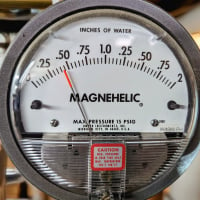Best Of
Re: Old house heating: Steam radiators or forced air?
If no "one wanted steam", this website would not exist. Think about it…………..
Re: Old house heating: Steam radiators or forced air?
Speaking as someone who went out specifically looking for a house with cast iron radiators because I like them, I'd say keep the steam and get rid of the wife.
😉
 ChrisJ
ChrisJ
Re: House heats up but thermostat is turned off AND thermostat's battery is dead
You are either going to have to start intelligent troubleshooting — or hire someone who can.
It's not rocket science. Start at the circulator which is running when it shouldn't be. Trace it's power wires back to what ever controls it. At the control there will be a power feed — and a control feed from something else. Disconnect the control feed from something else. Circulator stops? Wonderful. Now trace back those control wires to whatever. Disconnect them at that end. Circulator stops? Wonderful. Circulator doesn't stop? Problem in the wires.
And so on.
Re: Old house heating: Steam radiators or forced air?
Steam and HW are only a fraction of the systems installed. Hot air is the king in most of the country whether we like it or not.
Nothing wrong with hot air if it done right unfortunately it seldom is. Hot air will be unsatisfactory in some buildings like masonary construction. Low ceilings with overhead supplies are a problem occupants can feel air movement. And overhead heat supply is never good.
Most jobs have undersized ductwork that can't be balanced
Re: Old house heating: Steam radiators or forced air?
In michigan even in old houses steam or hot water aren't common, there is some but most were gravity warm air.
Re: Old house heating: Steam radiators or forced air?
Most suburban folks live in newer houses — many of them less than 30 years old — where everything was done to go cheap. And forced air is cheap to install in a new build (not as a retrofit). Most people living in denser cities on the east coast have steam, because their buildings are mostly pre-WWII or even earlier, and are much more compact and forced air was almost unheard of (gravity air, yes, but only for the very high end mansions).. Most rural homes will be steam or hot water.
But… the ones who squeak and the ones who post are the suburban ones, so there is an illusion that "almost no one has it in their own home".
Re: Cold water is hot due to amateur plumbing
You have a cross-connection somewhere. The usual suspects...
- Single handle mixing valves like shower bodies, Washing Machine valves.
- Mop Sink connections that are altered.
- Domestic hot water coils using a globe valve to blend.
Yes, you also may need a check valve, but when this condition "suddenly" occurs, it's usually at the aforementioned locations. Mad Dog
Take batteries out
One thing we all do but shouldn't is leave batteries in test equipment. I had a piece of electrical equipment that was only 11 months or so old a Klein Circuit Tracer. I pulled it out and have been debating weather to sell it or not. They are a little bit north of $200 new. Only used a couple of times.
i posted it on Marketplace and had a buyer for $100 within an hour or so. I never doubted it would work.
I fired it up and it won't power up so I thought batteries were dead. Pulled the back off and its all corroded.
I spent an hour cleaning it up, backing soda etc and dried it our good with a fan.
It's toast.
I guess the cheap China batteries it came with leaked all over the place.😕😕😕😕 Now I guess I will go check my other tools with batteries.
Re: Off grid heating/ac minisplit efficiency
Open windows?
Depending on the heat load 1 to 3_Tons of cooling will be needed. can the solar handle that kind of start-up load?
 pecmsg
pecmsg

